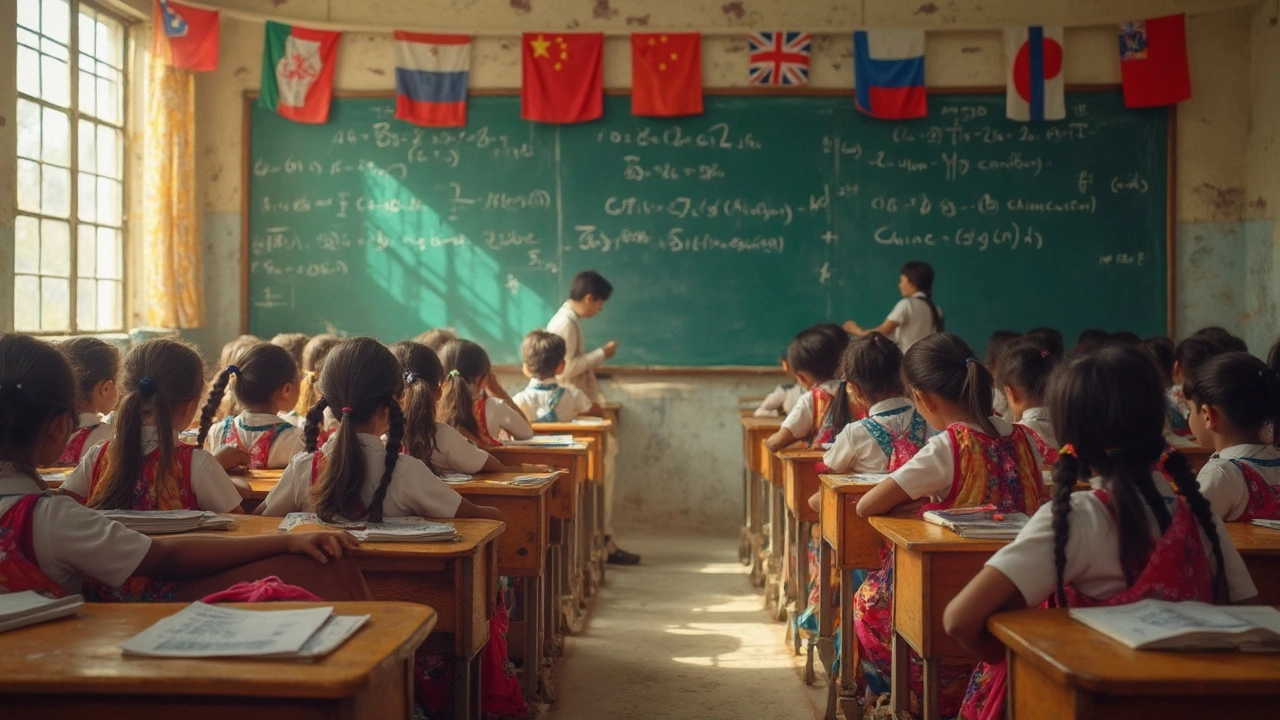Ever wonder which country dishes out the roughest math problems in their competitive exams? You’re not alone. If you've stared at a brain-buster from the International Math Olympiad and thought, “Seriously, who solves this?”—well, kids in some countries have been grinding away at stuff like this since middle school.
Some countries are obsessed with competitive math. In places like China, Russia, and South Korea, these exams can make or break your future—no pressure, right? Universities and even employers pay close attention to your performance. Math there isn’t just a subject, it’s a sport. And trust me, the training can get pretty intense. You’ll find after-school bootcamps, private tutors, even special textbooks designed, basically, to make your brain hurt.
- What Does 'Hardest Math' Even Mean?
- Meet the Biggest Math Exams Worldwide
- Why Some Countries Make Math So Brutal
- Showdown: Comparing Real Exam Problems
- Surprising Facts About Math Training
- Tips for Surviving Tough Math Exams
What Does 'Hardest Math' Even Mean?
So, what makes math "hard" in one country but just another Tuesday in another? It usually boils down to the types of problems, the time pressure, and the depth of knowledge expected. When we talk about the hardest math on competitive exams, it’s not just about big numbers or scary formulas. It’s more about creativity. The toughest questions often need outside-the-box thinking, not just memorization or speed.
Take contests like the International Math Olympiad (IMO) or country-level exams like Russia’s Unified State Exam or China's Gaokao. The questions go deep. You’ll run into tricky algebra twists, geometry puzzles, and problems where you have to prove something, not just solve for x. Some problems might even look more like riddles than math homework.
One thing that makes math "hard" is the format—like, is it multiple choice, or do you have to write out your thinking step by step? Many of the toughest exams have no shortcuts. You can’t just guess your way through.
Another factor is time. For example, in the Chinese Gaokao, students have about two hours to work through problems that might take a non-prepped adult half a day to even understand. Here’s a quick look at how time and problem numbers stack up for famous math exams:
| Exam | Time Limit | Typical Problems |
|---|---|---|
| IMO | 4.5 hrs/day (2 days) | 3 per day |
| Gaokao (China) | 2 hrs | 15-20 |
| Russia Unified State Exam | 3.5 hrs | 19 |
Finally, the hardest math questions usually demand a pile of skills all at once—logic, creativity, speed, and nerves of steel. So when people argue about which country has the hardest math in competitive exams, they’re really debating which places pack the most challenge into the exam time and ask for the widest, deepest kind of smarts.
Meet the Biggest Math Exams Worldwide
When people talk about the hardest math on the planet, what they usually mean are the challenges in the world’s toughest math contests. Here’s the real lineup you should know about:
- International Mathematical Olympiad (IMO): This is basically the Olympics for high school math nerds. Every country sends their best six students. Problems range from geometry twists to number theory puzzles that stump even some adults with PhDs. Scoring is brutal—some questions take hours and barely anyone gets a perfect score.
- China’s Gaokao: This isn’t your average high school exit exam. The math portion is notorious for its mind-bending speed and complexity. In most provinces, you’ll find problems tougher than what university students in other countries deal with.
- Russian Math Olympiad: Legend has it even Russian engineers sweat over these questions. The regional and national rounds push math reasoning skills beyond textbook exercises, into hardcore logic and creativity territory.
- South Korea’s CSAT (Suneung): This college entrance exam features a math section so stressful that families set up prayer sessions for their kids. Some questions go viral for their absurd level of difficulty.
- Indian Regional and National Olympiads: To even qualify for the Indian National Maths Olympiad, you’ve got to make it through earlier rounds that filter out the best from thousands. The final paper is all proofs, no calculator, and expects clear, deep thinking.
| Exam Name | Country/Region | Max Points | Average Top Score |
|---|---|---|---|
| IMO | Global | 42 | Golds usually score 35+ |
| Gaokao (Beijing Region) | China | 150 | Elite students 135+ |
| CSAT | South Korea | 100 | Top 1% get 96+ |
Every one of these exams is filled with questions built to separate the good from the best. Many students train year-round, sometimes starting as early as elementary school. If you think your math exam is tough, check out some problems from these competitions and see how you stack up.
Why Some Countries Make Math So Brutal
Ever looked at a math problem and thought it was written in alien code? In China, Russia, and South Korea, that’s actually the point. Their school systems and exams like the Gaokao in China want to weed out only the top problem-solvers. The bar is sky-high because these countries link math success straight to big life opportunities—like getting into the country’s best universities, which can totally change your career.
The pressure from society and families is no joke. Parents push hard, right from early childhood. I’ve met folks in Beijing who told me their daily routine as teens was pretty much Eat. School. Math practice. Repeat. Failing a big math exam is more than just a bad grade. For some, it’s a missed shot at the life they (or their parents!) dreamed of.
Why else do they do it? It’s about national pride. International competitions, like the International Math Olympiad (IMO), are a huge deal. A win means your country stands out as the smartest. Some countries pour resources into math clubs, special schools, and government-funded training camps. In Russia, there are math circles for talented kids, and in South Korea, specialized 'math high schools' are a real thing.
- China: The Gaokao math section covers topics well beyond U.S. high school level. There are proofs, tough geometry, and logic riddles, sometimes harder than questions at top American universities.
- Russia: Their Olympiad-style problems land somewhere between a puzzle and a mini research paper. The goal isn’t just the answer—it’s creativity and pure logic.
- South Korea: The university entrance exams (like the KSAT) often have problems that test how well you can improvise under pressure, not just memorize rules.
| Country | % Students in Math Training Programs |
|---|---|
| China | ~40% |
| South Korea | ~36% |
| Russia | ~31% |
So, if you ever stare at one of those hardest math problems and wonder "why does this exist?"—remember, in some places, mastering brutal math isn’t just smart. It’s survival.

Showdown: Comparing Real Exam Problems
If you’re curious where the hardest math problems pop up around the world, let’s get real and look at the kinds of questions that actually show up on top-level exams.
China’s Gaokao math section is basically the stuff of legend. Picture this: a three-hour paper packed with logic puzzles, calculus, probability, and even geometry proofs. One question from 2022 read: “Given functions f(x) and g(x) with certain properties, how many solutions does the equation f(g(x)) = g(f(x)) have for x in [0, 1]?” These aren’t just plug-and-chug numbers—think layers of logic and creative steps.
Flip over to Russia. The Russian Math Olympiad features old-school Soviet-style brain teasers. Expect questions like: “From all three-digit numbers, find how many are divisible by 7 but not by 9.” Looks innocent, right? But the solution process can take a real math wizard.
South Korea doesn’t mess around either. The College Scholastic Ability Test, known as the CSAT, is legendary for tripping up even the brightest. You might see problems weaving together trigonometry, sequences, and logic in one nasty problem.
Here’s a quick side-by-side on what you can expect:
| Country | Exam Name | Sample Question Style |
|---|---|---|
| China | Gaokao | Multi-step calculus and logic problems |
| Russia | Russian Math Olympiad | Classic number theory and tricky wordings |
| South Korea | CSAT | Integrated, real-world application questions |
And of course, the International Math Olympiad (IMO) cranks the hardest math dial up to eleven for everyone. A classic IMO problem: “Let a, b, c be positive reals such that abc = 1. Show that (a-1+1/b)(b-1+1/c)(c-1+1/a) ≤ 1.” That problem alone has left plenty of students worldwide stuck for hours.
Noticing a pattern? The main difference is how these exams combine several math topics in a way that forces you to get creative, not just memorize formulas. If you want to see if you could survive the hardest math exams, try solving a few samples from each country. It’s a real wake-up call!
Surprising Facts About Math Training
If you thought hardcore math training was only for college kids, you’re in for a shock. In countries where hardest math is part of the culture, even elementary school students get pulled into super tough prep classes. In China, kids as young as eight attend weekend math 'cram schools' that feel more like mini-universities. Parents sign them up for math circles and problem-solving clubs ages before any real exams even start.
Here’s the wild part: Russian math schools run special classes in the evenings, sometimes inside actual universities. It’s totally normal for a teenager in Moscow to spend their afternoons working on Olympiad problems that a college student in the U.S. might struggle with. In Singapore, they've even developed school math curriculums that are famous for being intense. The national method is so systematic and effective that American schools have literally imported the "Singapore Math" approach hoping their students will catch up.
Want some numbers? More than 400,000 students in India take math Olympiad qualifiers each year, hoping just to make it to the next round. In China, the national Olympiad program handpicks about 60,000 of the top scorers from millions of schoolkids for afterschool training camps. The level of competition is nuts—kids compete for spots like athletes trying out for the Olympics.
| Country | Training Start Age | Typical Weekly Hours |
|---|---|---|
| China | 7-8 | 6-10 |
| Russia | 9-10 | 8-12 |
| South Korea | 8-9 | 8-15 |
Another surprise: in some countries, being a “mathlete” is cool. South Korean high schoolers who do well in math contests may get university admission boosts or even military service perks. Meanwhile, in Romania and Vietnam you’ll find small towns coming together to support their local math stars. In these places, it’s not weird to have family dinners turn into full-on math strategy sessions.
If you want to see just how committed these countries are to competitive exams, look up old Olympiad problem sets from China or Russia. Warning: these questions have stumped top-class adults. And yet, their students see them as routine homework.
Tips for Surviving Tough Math Exams
When you're staring down the barrel of a hardest math exam, it’s about more than just knowing formulas. The top scorers don’t have superpowers—they follow certain strategies that anyone can use, with enough practice and the right mindset.
- Practice with Real Exam Problems: If you're aiming for the level of China’s Gaokao or Russia’s math Olympiads, just doing regular schoolwork isn’t enough. Hunt down real past exam questions. The Internet is full of these if you just search for the test by name. Spend time analyzing how each problem works—don’t just memorize answers.
- Get Help When Stuck: Don’t waste hours spinning your wheels over one problem. Ask a teacher, join an online forum like Art of Problem Solving, or work with a study group. Sometimes a different brain sees what you don’t.
- Work Under Timed Conditions: One nasty surprise in a competitive exam is the clock. Set a timer and try whole problem sets at the exam pace. This helps you avoid panic and gets you used to thinking fast.
- Master the Basics: In countries like South Korea, school kids drill fundamentals until they’re automatic. Most "impossible" problems use basic concepts in tricky ways, so nail the foundation—it matters more than memorizing obscure tricks.
- Build Stamina: The hardest tests, like the Chinese National Olympiad, can run for hours. Try back-to-back practice sessions so your brain doesn’t fade halfway.
- Stay Calm When You’re Stumped: Everyone gets stuck, even the champs. Take a breath and move on. If time’s up, write down what you do know—you might snag partial credit.
Here’s a look at how long some of these intense exams actually run:
| Country | Major Exam | Duration |
|---|---|---|
| China | Gaokao (Math section) | 120 minutes |
| Russia | All-Russian Math Olympiad | 4 hours 30 min |
| USA | AMC/AIME (Math Olympiads) | 75-180 minutes |
It’s not always about who’s the smartest; it’s about who prepares the right way. If students in the hardest math countries can handle it, so can you—just focus on proven strategies, give yourself grace, and keep grinding.



